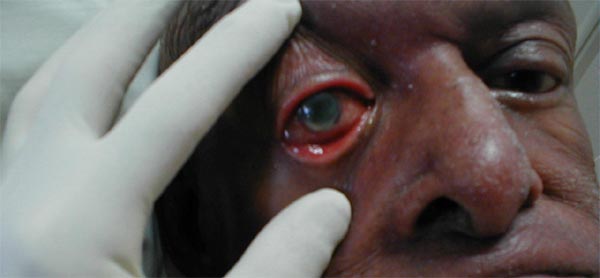Corneal ulcer (patient information)
For the WikiDoc page for this topic, click here
| Corneal ulcer | |
 | |
|---|---|
| Corneal ulcer. Marked generalized inflammation related to bacterial infection in this immunocompromised host. The cornea itself has become opaque secondary to this process. (Image courtesy of Charlie Goldberg, M.D.) | |
| ICD-10 | H16.0 |
| ICD-9 | 370.00 |
| MedlinePlus | 001032 MedlinePlus2 |
Editor-In-Chief: C. Michael Gibson, M.S., M.D. [1]; Patient Advocacy Editor(s)-In-Chief: Erin Lord; Amanda Chirlin
Overview
A corneal ulcer is an erosion or open sore in the outer layer of the cornea, the transparent area at the front of the eyeball that covers the iris and pupil.
What are the symptoms of a corneal ulcer?
Corneal ulcers are extremely painful due to nerve exposure, and can cause tearing and squinting.
Other symptoms include:
- Eye burning, itching and discharge
- Eye pain
- Eye redness
- Impaired vision
- Sensitivity to light (photophobia)
- Watery eyes
- White patch on the cornea
- Signs of anterior uveitis, such as miosis (small pupil), aqueous flare (protein in the aqueous humour), and redness of the eye
What are the causes of a corneal ulcer?
Corneal ulcers are most commonly caused by an infection with bacteria, viruses, fungi or parasites. Because bacteria can more easily penetrate a damaged cornea than a healthy one, a corneal ulcer is more likely to occur after some type of injury or trauma to the eye (e.g. tiny scratches from foreign particles that enter the eye).
Inappropriate contact lens wear (e.g. wearing the lenses overnight or not using proper hygiene when handling the lenses) may also lead to a corneal ulcer. Furthermore, a contact lens may damage the cornea as it scratches against the surface upon removal, thereby allowing easier bacterial penetration [1]
Examples of viruses, fungi, and parasites that can cause corneal ulcers are:
- Herpes simplex - This virus can lead to herpes simplex keratitis, which is a serious viral infection that may cause repeated attacks that are triggered by stress, exposure to sunlight, or any condition that impairs the immune system.
- Fusarium - These fungi have been associated with fungal keratitis. The infection can occur after a corneal injury involving plant material, such as from a tree branch, or in immunosuppressed people.
- Acanthamoeba - These parasites can lead to acanthamoeba keratitis mostly in contact lens users, especially those who attempt to make their own homemade cleaning solutions. It can also cause problems for people who wear their contact lenses while swimming.[2]
Other causes of corneal ulcers include:
- Abrasions (scratches)
- Foreign bodies in the eye
- Inadequate eyelid closure
- Severely dry eyes
- Severe eye allergies
- Various inflammatory disorders
- Chemical burns that can injure the cornea [3]
Who is at highest risk?
People with poor eye hygiene and contact lens abusers (e.g. those who wear contact lenses overnight) are at an increased risk of developing corneal ulcers.
Corneal ulcers are a common condition in humans, particularly those living in the tropics and in agrarian societies.
In developing countries, children afflicted by vitamin A deficiency are at a high risk for corneal ulcer and may become blind in both eyes, which may persist lifelong if not treated.
How to know you have a corneal ulcer?
A corneal ulcer is diagnosed by an ophthalmologist or optometrist when performing certain tests, including:
- Examination of scrapings from the ulcer
- Fluorescein stain of the cornea
- Keratometry (measurement of the cornea)
- Pupillary reflex response
- Refraction test
- Slit-lamp examination
- Tear test
- Visual acuity
Blood tests to check for inflammatory disorders may also be needed.
When to seek urgent medical care?
Call your health care provider if you develop impaired vision, severe light sensitivity, or eye pain.
Treatment options
Treatment of corneal ulcers and infections depends on the cause. They should be treated as soon as possible to prevent further injury to the cornea. Patients usually start treatment with an antibiotic that is effective against many bacteria. More specific antibiotic, antiviral, or antifungal eye drops are prescribed as soon as the cause of the ulcer has been identified.
Corticosteroid eye drops may be used to reduce inflammation in certain conditions.
Severe ulcers may need to be treated with corneal transplantation.
Where to find medical care for a corneal ulcer
Directions to Hospitals Treating Corneal Ulcer
Prevention of a corneal ulcer
Contact lens wearers must be sure to wash their hands and pay very close attention to cleanliness while handling their lenses to prevent corneal ulcers. Also, contact lenses should not be worn overnight or when swimming, and eye lubricants should be used prior to lens removal to avoid scratches due to dryness.
Prompt, early attention by an ophthalmologist or optometrist for an eye infection may prevent ulcers from forming.
What to expect (Outlook/Prognosis)?
With proper, prompt treatment, the outlook is very good. However, if left untreated, a corneal ulcer or infection can permanently damage the cornea. Untreated corneal ulcers may also perforate the eye (cause holes), resulting in the spread of the infection inside, increasing the risk of permanent visual problems.
Possible complications include:
- Loss of the eye
- Severe vision loss
- Scars on the cornea
Additional Links
http://www.nlm.nih.gov/medlineplus/ency/article/001032.htm